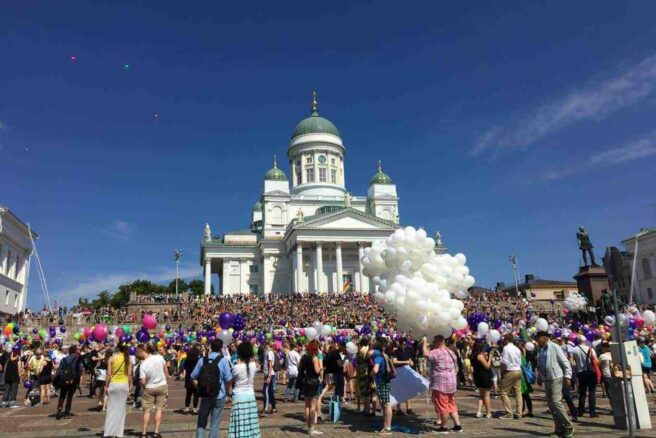Synchrony-induced compassion could be the common nominator between football chants, war chants and peace chants with militarised-synchronised movement at the core of community building.
Listen to the article, read by writer Susanna Hast:
What will we remember from the UEFA Euro 2016? My prediction is: Iceland advancing all the way to the quarter-finals as the heroic team of a tiny nation. Such a success story depicts the team and the entire population of a seemingly trivial nation rising to defeat the top teams. Periphery defeats the centre.
Underdog heroism is why we love the story.
Iceland’s football team is an erupting volcano whose victory is due to unity. This underdog heroism is why we love the story. It resembles Finns in the Winter War.
But one of the most stunning part of team Iceland was its fans, who were chanting ‘UH’ while clapping their hands, speeding the tempo gradually.
In particular, I was impressed by the timing, because the chanting began with a rather big time gap in the middle, and it could be difficult to keep the beat.
At least in some parts of the stadium the fans used a drum, but one small drum could only reach part of the crowd and the rest would have to pick up the corporeal message of timing from the surrounding people. Participating through the television screen, my chants would have been wrongly timed.
When grouped in one part of the football stadium, the fans could act simultaneously, in synchrony.
But when grouped in one part of the football stadium, the fans could act simultaneously, in synchrony. Those not in the same space have a harder time to follow the timing because they lack the other physical bodies in the same space whose rhythm to follow.
In a large group the synchrony is less precise of course, but the quantity compensates for quality, and the impression of synchrony is strong enough.
There is some very powerful emotion in bodies moving collectively. In the homecoming celebration of team Iceland, the bodies were in the thousands, chanting and clapping with the beat of a drum. The non-linguistic, the pre-discursive pulse of life. It is quite something. Even at such a distance, it gives me the chills.
War chant
The Icelandic football fans’ chant has been called a “viking war chant”. It indicates a nation-building taking place, as is typical for international sports contests.
This makes me think about nation or community building related to war by synchronised movement and voice/noise.
Even if foot drill has become less relevant in actual warfare, military training includes synchronised marching.
Preparation for war, military training, active warfare, resistance of war, post-war community building do all contain elements of synchronised movement. As an example, Chechens have used the ancient sufi ritual zikr, a praise for Allah with men chanting and moving in a whirl, to prepare for battle.
How about North Korean military marches? Military training typically includes synchronised marching and singing, all over, even if foot drill has become less relevant in actual warfare.
Imagine the sound of a machine gun firing (popular culture and war reporting enables an access to the soundscape if not experienced first hand). That violent repetitive noise, even when only imagined, can make your body shake in a rhythm.
Imagine people gathering on a square to protest chanting slogans. The louder the better, but in particular, the more people chanting in synchrony, the more chills.
The militarised synchrony and protest synchrony tend to be hyper-masculine alike, emphasising a certain bodily capacity and posture of action and force.
Physicality connecting
I went to Helsinki Pride last weekend marching. I was situated in a part of the crowd where synchrony was lacking, voice and movement were not collective, thus, there was not much emotion either.
We were mostly standing because the advancement was so slow, and it was not possible to walk in any rhythm. I found myself chatting, wondering and disconnected.
I stepped out from the marching crowd to the sideway, and eventually saw a group called “Bears”, a gay subculture, appear. They were moving a flag up and down as a group.
I felt in rhythm with something again. The Bears were dancing so that their hands moved in a synchronised way creating a visual effect of collective movement.
Without any knowledge of their agenda, their culture, their joy or suffering (I did not even know the group’s name), it was effortless to feel something together by connecting to the collective movement.
Emotion is embodied in the physical act of synchronised movement and sound.
Another example is capoeira, a Brazilian martial arts. The importance of synchronised movement is not only in the rhythmical clapping of hands, playing instruments, and singing in a circle around the two players, but also in the way that the players in roda need to tune to the play style of their partner, and act and react always in relation to the body of the other.
The intensity of that experience is in relation to the synchronised movement which, like the football fans’ chanting, speeds up towards the end of the roda.
In a similar way you are not just supporting the players but you are creating a sense of belonging in a very physical, corporeal and carnal way. Emotion is embodied in the physical act of synchronised movement and sound.
It is not surprising then, that a group of capoeristas has brought the training to refugee camps for kids and youth affected by conflict, and they are seeing the results in the creation of not just physical, but spiritual connections.
Synchrony and compassion
In a clinal study by Percarlo Valdesolo and David DeSteno (2011) synchronised tapping of the participant and the ”victim” correlated with feelings of similarity more than in the case of unsynchronised tapping.
The synchronised tapping also correlated with compassion and willingness to help. The participant would more likely help the victim if she had tapped a sensor in synchrony with the victim. Valdesolo and DeSteno refer to this as synchrony-induced compassion.
Curiously, this synchrony-induced compassion could be the common nominator between football chants, war chants and peace chants with militarised-synchronised movement at the core of community building.
With synchrony comes a power to move people, for better or for worse.




